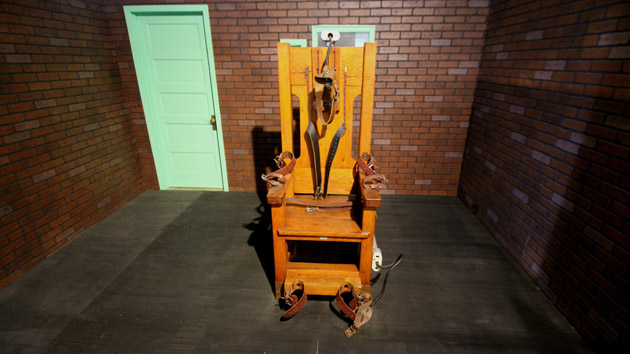
The lethal injection room at California's San Quentin State PrisonCalifornia Department of Corrections and Rehabilitation
Update: Oklahoma canceled the second execution after the first one went horribly awry. According to the New York Times, after he’d been declared unconscious, prisoner Clayton D. Locket twitched and gasped and said “man” and “something’s wrong,” before dying of a heart attack.
Tonight Oklahoma will continue the nation’s ongoing experiment in executing people with untested drug combinations as it moves to kill death row inmates Clayton D. Lockett and Charles Warner using a new, secretly acquired drug cocktail.
Officials in Oklahoma and other states have resorted to these methods because they can no longer access sodium thiopental, the anesthetic traditionally used in lethal injections, and another drug used to paralyze the condemned. The lone US manufacturer quit producing sodium thiopental in 2011, and international suppliers—??particulalry in the European Union, which opposes the death penalty on humanitarian grounds—??have stopped exporting both drugs to the United States. This has left states like Oklahoma scrambling to find new pharmaceuticals for killing death row inmates. Some have been reduced to illegally importing the drugs, using untested combinations, or buying from unregulated compounding pharmacies, a number of which have a history of producing contaminated products.
Death row inmates and their lawyers have protested on the grounds that these untested protocols could produce a level of suffering that violates the Eighth Amendment prohibition on cruel and unusual punishment, and they’ve sued for more information about the source and purity of the drugs. In response, several states have passed secrecy laws, allowing them to keep the names of their suppliers, and in some cases the contents of the lethal injection, under wraps. (Oklahoma is so eager to hide the source of its death drugs that it buys them with petty cash so there are no transaction records.) Death row inmates, in turn, have filed suits challenging the constitutionality of these secrecy statutes.
In February, Lockett and Warner prompted a high-profile showdown between Oklahoma officials when they sued the state, asserting that its execution protocol could inflict “severe pain” in violation of the Eighth Amendment. A lower state court found the drug secrecy law patently unconstitutional, and the state Supreme Court ultimately stayed the two men’s executions until the issues were fully litigated. But Republican Gov. Mary Fallin insisted they be executed regardless of the court’s ruling, prompting a political crisis. On April 23, the Oklahoma Supreme Court, whose justices are now being threatened by the Legislature with impeachment, caved and allowed the executions to move forward.
The public knows very little about the drugs that will be used to kill Lockett and Warner who stand convicted of murder. ??Lockett shot a teenage girl, then buried her alive, while Warner raped and killed his girlfriend’s 11-month-old daughter in 1997. Initially, the state said it would deploy a three-drug cocktail, including the sedative pentobarbital (normally used to euthanize animals), vercuronium bromide (which paralyzes the inmate so onlookers can’t tell if he’s suffering), and potassium chloride (which stops the heart?). The first drug is supposed to knock out the inmate so he doesn’t feel pain, but pentobarbital, which states substituted for sodium thiopental after it went off the market, works more slowly than the old drug, and it wasn’t tested in advance to make sure it was an appropriate substitute. Also, lawyers argue that it doesn’t prevent pain during an execution. For that reason, injecting it into a conscious animal in California is actually a crime.
Due to a shortages of pentobarbital and vercuronium bromide, Oklahoma planned to buy the drugs from an unnamed compounding pharmacy. This was problematic because such pharmacies are unregulated, and contaminated pentobarbital can result in excruciatingly painful deaths. (Experts say it can feel as though the insides of a person’s veins are being scraped with sandpaper.) South Dakota used a compounded pentobarbital contaminated with a fungus to execute Eric Robert in 2012. During the execution, he repeatedly opened his eyes—a sign that the drug wasn’t working, some experts said. Oklahoma has had similar problems. In January, it executed another man, Michael Lee Wilson, using pentobarbital from an unidentified compounding pharmacy. During the execution he sputtered, “I feel my whole body burning,” another sign that the drug wasn’t doing its job.
In March, Oklahoma backed away from this approach and said it would instead use one of five possible drug combinations, including a two-drug cocktail of midazolam (a sedative) and hydromorphone (a pain killer). When states first proposed using those drugs in lethal injection mixes last year, defense lawyers and medical experts warned that inmates receiving them would essentially suffocate to death. Brushing aside these concerns, in January Ohio used the drugs to execute Dennis McGuire, who gasped and convulsed horribly for more than 10 minutes before taking a record 26 minutes to die. His family, who watched in horror, is now suing over what they allege was cruel and unusual punishment.
Oklahoma has since shifted course again and announced that it would use a three-drug combo that includes midazolam and pancuronium bromide. According to Madeline Cohen, an assistant federal public defender representing Charles Warner, the state claims that both drugs are being purchased from manufacturers rather than compounding pharmacies but wouldn’t provide any other information. The only known use of this drug combination for executions was in Florida in 2013, but Florida used five times the dose of midazolam that Oklahoma plans to use, meaning Lockett and Warner will essentially be human guinea pigs. “It is an experiment, and I don’t think anybody is absolutely certain what will happen in Oklahoma,” says Richard Dieter, executive director of the Death Penalty Information Center. Dieter adds that we’ll never know whether the drugs worked properly or caused needlessly painful deaths because the people who could tell us will be dead.












